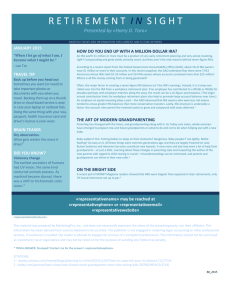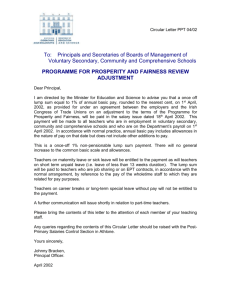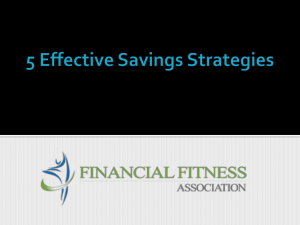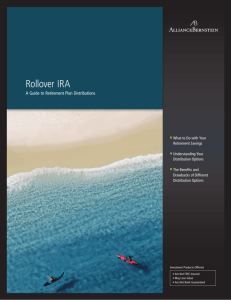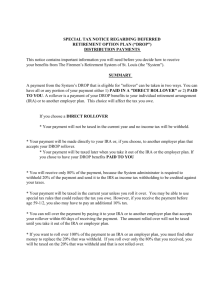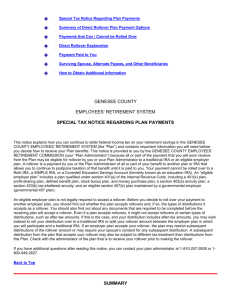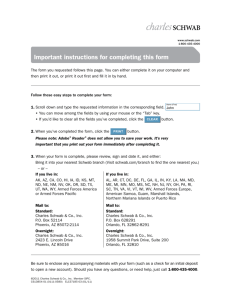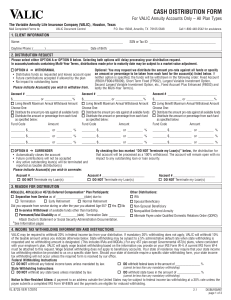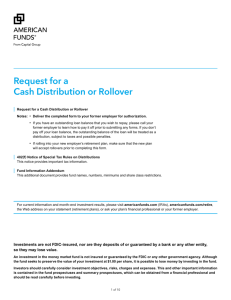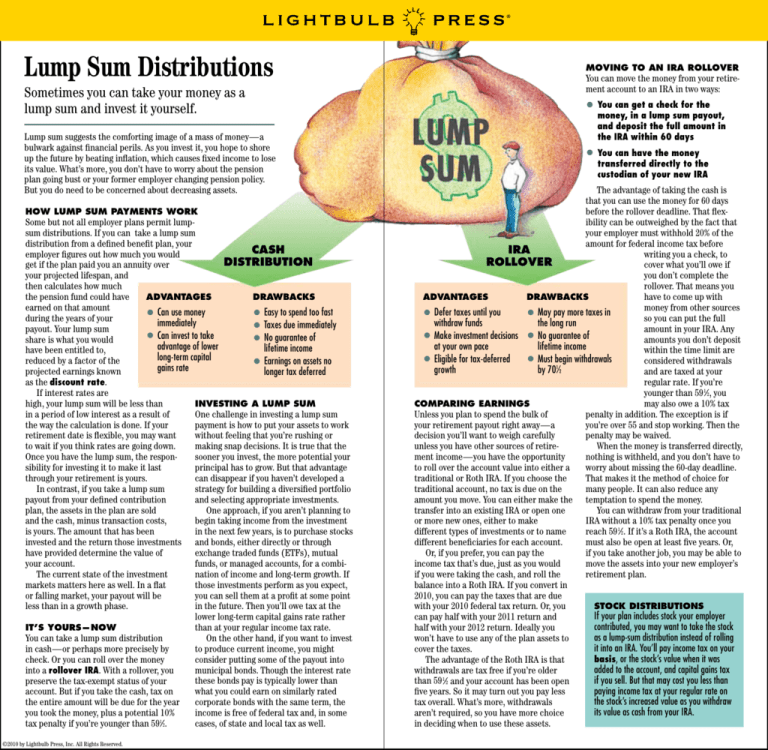
®
R E T I R E M E N T
I N C O M E
Lump Sum Distributions
MOVING TO AN IRA ROLLOVER
Sometimes you can take your money as a
lump sum and invest it yourself.
s You can get a check for the
Lump sum suggests the comforting image of a mass of money—a
bulwark against financial perils. As you invest it, you hope to shore
up the future by beating inflation, which causes fixed income to lose
its value. What’s more, you don’t have to worry about the pension
plan going bust or your former employer changing pension policy.
But you do need to be concerned about decreasing assets.
HOW LUMP SUM PAYMENTS WORK
Some but not all employer plans permit lumpsum distributions. If you can take a lump sum
distribution from a defined benefit plan, your
CASH
employer figures out how much you would
DISTRIBUTION
get if the plan paid you an annuity over
your projected lifespan, and
then calculates how much
ADVANTAGES
DRAWBACKS
the pension fund could have
earned on that amount
Can use money
Easy to spend too fast
during the years of your
immediately
Taxes due immediately
payout. Your lump sum
Can
invest
to
take
No guarantee of
share is what you would
advantage of lower
lifetime income
have been entitled to,
long-term capital
reduced by a factor of the
Earnings on assets no
gains rate
projected earnings known
longer tax deferred
as the discount rate.
If interest rates are
high, your lump sum will be less than
INVESTING A LUMP SUM
in a period of low interest as a result of
One challenge in investing a lump sum
the way the calculation is done. If your
payment is how to put your assets to work
retirement date is flexible, you may want
without feeling that you’re rushing or
to wait if you think rates are going down.
making snap decisions. It is true that the
Once you have the lump sum, the responsooner you invest, the more potential your
sibility for investing it to make it last
principal has to grow. But that advantage
through your retirement is yours.
can disappear if you haven’t developed a
In contrast, if you take a lump sum
strategy for building a diversified portfolio
payout from your defined contribution
and selecting appropriate investments.
plan, the assets in the plan are sold
One approach, if you aren’t planning to
and the cash, minus transaction costs,
begin taking income from the investment
is yours. The amount that has been
in the next few years, is to purchase stocks
invested and the return those investments and bonds, either directly or through
have provided determine the value of
exchange traded funds (ETFs), mutual
your account.
funds, or managed accounts, for a combiThe current state of the investment
nation of income and long-term growth. If
markets matters here as well. In a flat
those investments perform as you expect,
or falling market, your payout will be
you can sell them at a profit at some point
less than in a growth phase.
in the future. Then you’ll owe tax at the
lower long-term capital gains rate rather
than at your regular income tax rate.
IT’S YOURS—NOW
On the other hand, if you want to invest
You can take a lump sum distribution
to produce current income, you might
in cash—or perhaps more precisely by
consider putting some of the payout into
check. Or you can roll over the money
municipal bonds. Though the interest rate
into a rollover IRA. With a rollover, you
these bonds pay is typically lower than
preserve the tax-exempt status of your
what you could earn on similarly rated
account. But if you take the cash, tax on
corporate bonds with the same term, the
the entire amount will be due for the year
income is free of federal tax and, in some
you took the money, plus a potential 10%
cases, of state and local tax as well.
tax penalty if you’re younger than 591⁄2.
s
s
©2010 by Lightbulb Press, Inc. All Rights Reserved.
s
s
s
s
You can move the money from your retirement account to an IRA in two ways:
money, in a lump sum payout,
and deposit the full amount in
the IRA within 60 days
s You can have the money
transferred directly to the
custodian of your new IRA
The advantage of taking the cash is
that you can use the money for 60 days
before the rollover deadline. That flexibility can be outweighed by the fact that
your employer must withhold 20% of the
amount for federal income tax before
IRA
writing you a check, to
ROLLOVER
cover what you’ll owe if
you don’t complete the
rollover. That means you
ADVANTAGES
DRAWBACKS
have to come up with
money from other sources
Defer taxes until you
May pay more taxes in
so you can put the full
withdraw funds
the long run
amount in your IRA. Any
Make investment decisions
No guarantee of
amounts you don’t deposit
at your own pace
lifetime income
within the time limit are
Eligible for tax-deferred
Must begin withdrawals
considered withdrawals
growth
by 701⁄2
and are taxed at your
regular rate. If you’re
younger than 59 1⁄2, you
may also owe a 10% tax
COMPARING EARNINGS
penalty in addition. The exception is if
Unless you plan to spend the bulk of
you’re over 55 and stop working. Then the
your retirement payout right away—a
penalty may be waived.
decision you’ll want to weigh carefully
When the money is transferred directly,
unless you have other sources of retirenothing is withheld, and you don’t have to
ment income—you have the opportunity
worry about missing the 60-day deadline.
to roll over the account value into either a
That makes it the method of choice for
traditional or Roth IRA. If you choose the
many people. It can also reduce any
traditional account, no tax is due on the
amount you move. You can either make the temptation to spend the money.
You can withdraw from your traditional
transfer into an existing IRA or open one
IRA without a 10% tax penalty once you
or more new ones, either to make
reach 59 1⁄2. If it’s a Roth IRA, the account
different types of investments or to name
different beneficiaries for each account.
must also be open at least five years. Or,
Or, if you prefer, you can pay the
if you take another job, you may be able to
income tax that’s due, just as you would
move the assets into your new employer’s
if you were taking the cash, and roll the
retirement plan.
balance into a Roth IRA. If you convert in
2010, you can pay the taxes that are due
STOCK DISTRIBUTIONS
with your 2010 federal tax return. Or, you
If your plan includes stock your employer
can pay half with your 2011 return and
contributed, you may want to take the stock
half with your 2012 return. Ideally you
as a lump-sum distribution instead of rolling
won’t have to use any of the plan assets to
it into an IRA. You’ll pay income tax on your
cover the taxes.
basis, or the stock’s value when it was
The advantage of the Roth IRA is that
added to the account, and capital gains tax
withdrawals are tax free if you’re older
if you sell. But that may cost you less than
than 59 1⁄2 and your account has been open
paying income tax at your regular rate on
five years. So it may turn out you pay less
the stock’s increased value as you withdraw
tax overall. What’s more, withdrawals
its value as cash from your IRA.
aren’t required, so you have more choice
in deciding when to use these assets.
s
s
s
s
s
s


